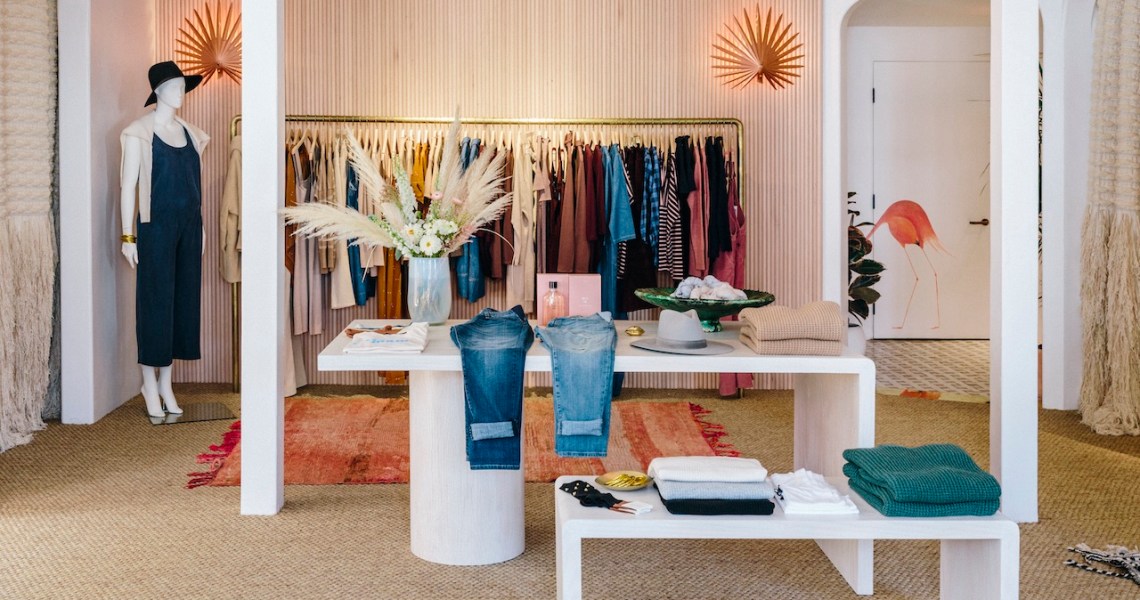Hatch is the latest DTC brand to go all in on physical retail.
The maternity brand opened a flagship store in New York’s SoHo neighborhood in 2017 and another store in Los Angeles in late 2018, and now founder Ariane Goldman is planning on making an ambitious play toward rapidly expanding the brand’s physical retail presence with 10 new stores over the next three years.
It’s an ambitious investment for Hatch, launched in 2011, but Goldman believes it’s worth the risk. She’s confident not only in her team’s business acumen but also in the current retail landscape that is hospitable to young DTC brands going physical.
Physical retail costs to entry are higher than ever, but Hatch is going in with a game plan for maintaining the level of foot traffic and revenue required to keep up with the costs of 12 retail stores.
Firstly, Goldman is envisioning the various Hatch stores as more than just a place for people to buy things. “Experiential” is a common buzzword thrown around, but in the maternity sector, Hatch has good reason to provide non-transactional experiences to its customers. Those experiences are typically classes led by professionals to prepare expecting mothers for the birthing process. The idea is that, while many of these topics can be found online, some topics such as lactation are harder to find in-person guidance on apart from consultations with medical professionals.
“Most of our competition is from big-box retailers with maternity lines, but there isn’t a community aspect there at all,” said Hatch founder Ariane Goldman. “We do a lot of in-store stuff outside of transactions: There’s a place to get ice cream and other snacks, we host in-store courses. People are smart today. They have a nose for bullshit; they can smell when you’re trying to sell them something, and they can tell when it’s authentic. That’s what we are trying to do with our community: make it authentic and real.”
Though apparel catering to certain fits, like plus-size or extra tall, are up, maternity sales from online stores, like Asos with its private-label maternity line, have fallen by 17 percent, according to an October report from retail platform Edited. The report attributes this to the fact that maternity, unlike height, is a temporary state, making shoppers more cautious to buy. Hatch addresses this by creating maternity clothes that can be continuously worn after the wearer is no longer pregnant.
Ad position: web_incontent_pos1
Hatch is tapping into a recent trend in DTC retail: Once, every DTC brand was scrambling to sell online due to the lower barrier to entry and less-crowded marketplace, but now there has been a reversal. Advertising on Instagram has become incredibly expensive, and the online DTC market is crowded with loads of similar brands. In response, many DTC brands are looking for a way to get into physical retail to stand out from the crowd.
“From a financial standpoint, the economics of the physical stores are pretty beneficial,” said Goldman. “The way we’ve designed our stores, they don’t cost a lot to build. Women spend two or three times what they spend online, which is really helpful. It’s just a bigger ROI for us all-around, compared to online.”
To support 10 new stores over the next three years, Hatch is relying on a combination of targeted social advertising and its first out-of-home campaign launched in Los Angeles to coincide with a new L.A. store. Additionally, the brand is banking on word-of-mouth generated by the in-store classes to spread awareness to potential new customers. These in-store experiences are going to be vital to Hatch’s long-term plan of building a cohesive and authentic community that will drive audience growth over time. Long-lasting relationships with consumers — even beyond the nine months when a customer is pregnant, in Hatch’s case — are incredibly valuable for young brands looking to establish themselves.
“Stores need to create a memorable, unique experience in order to keep people coming back,” said Ross Bailey, CEO of retail platform Appear Here. “You really need to come in with fresh ideas. Customers today have access to Instagram. They know everything there is to know about brands. Brands need to be one step ahead of them in terms of creating memorable experiences and building relationships.”




